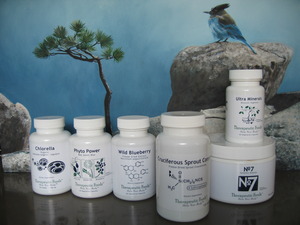Let Food Be Your Medicine—CS Complex
Dear Friends
It’s the season of harvest. Let [real] food be your medicine and let [real] medicine be your food. This slightly adjusted quote from Hippocrates, beautifully encapsulates the heart and soul of BioImmersion and the Therapeutic Foods Line. What you may not know regarding Hippocrates is that he built his first hospital in close proximity to a stream where watercress grew so that his patients would have ready access to this life-sustaining green.
We have our co-ops, CSAs (Community Supported Agriculture), farmers’ markets, even Wall Marts where we can secure organic foods. But it takes a matured belief to stay on track in the effort to secure alive food. And, even with organic foods, how do we know if they’re grown in mineral rich soil, or that they’re of a variety that contains a potent phytochemical load. We talked about this a couple of weeks ago in our newsletter, siting research that showed certain strains of golden delicious do not fulfill the apple motto of “keeping the doctor away”. Quite simply, they are heirlooms breed for sweatness, not for phytonutrient density.
This is the whole rational for the Therapeutic Foods, and I have posited over the last month the importance of consuming daily a number of these products such as the collection below in Clinical Notes. Let’s take a closer look at one of these—the Cruciferous Sprouts Complex.

The Cruciferous Sprouts Complex contains Broccoli, Daikon Radish, Red Radish, Kale, Mustard, Cabbage and Watercress—all as sprouts. Each as a mature plant known as powerhouses of health protecting phytonutrients, but what is not so widely known is that in their sprouted form their anti-cancer phytochemicals such as the glucosinolates family are a 10-100 times more concentrated. Let’s zero in on the watercress as an example. What’s special about Hippocrates’s Watercress?
Watercress (as are the others in this collection) is well know for containing glucosinolates, phytochemicals that are hydrolized to produce isothiocyanates, which have been studied for their anticancer effects. Dietary intake of these compounds has been shown to counter breast, lung, colorectal, head and neck, and prostate cancers. Watercress is also an exceptionally rich dietary source of nasturtiin, the precursor of phenethyl isothiocyanate (PEITC). Isothiocyanates are very potent inducers of Phase 2 Enzymes. So one is not only achieving protection against carcinogenesis and mutagenensis, but also enhancing Phase II liver detoxification activity, thereby additionally reducing toxicity of electrophiles and reactive forms of oxygen.
The key to achieving the highest concentrations of gluconsinotates is to harvest the sprouts on their third day of growth. Hence small quantities of cruciferous sprouts may protect against the risk of cancer as effectively as much larger quantities of mature vegetables of the same variety.
Supplementation such as this makes a lot of sense, doesn’t it?
HAVE A FANTASTIC LABOR DAY HOLIDAY EVERYONE!!!
Sincerely yours,
Seann Bardell
Clinical Notes:
The BioImmersion Therapeutic Foods Line is a new medical framework. Built with advanced technologies that maintain the wholeness of food, while utilizing the exact science of molecular concentration for therapeutic purposes. The results are foods that behave medicinally in the body. Repairing, healing, protecting, preventing—that is the power of food. As we like to say: Welcome to the world of BioImmersion.
A suggested daily protocol for protection:
- Organic Chlorella- 4 tabs daily
- Ultra Minerals- 4 tabs daily
- Phyto Power- 2 capsules daily
- Cruciferous Sprouts Complex- 2 capsules daily
- Wild Blueberry Extract- 1 capsule daily
- Pick one of our probiotic (synbiotic) products for daily use: the Original Synbiotic, Beta Glucan Synbiotic, High ORAC Synbiotic, Triple Berry Probiotic, Supernatant Synbiotic, Cranberry Pomegranate Synbiotic or the Number 7 Systemic Booster. They are all excellent.
No herbacides or pesticides used on the fields of harvest for our products.
The Last Quiz Answer:
How would you like to be swimming amongst this school of hammerhead sharks? They are an amazing fish! Their wide-set eyes give them a better visual range than most other sharks. And by spreading their highly specialized sensory organs over their wide, mallet-shaped head, they can more thoroughly scan the ocean for food. The great hammerhead is the largest of the nine identified species of this shark. It can grow up to 20 feet in length and weigh up to 1,000 pounds.


On September 16th at 7:30pm the Town Hall Seattle presents The Story of Stuff Project’s Annie Leonard in conversation with Eric Assdourian of the World Watch Institute and Chip Giller of Grist. Why don’t we all go!